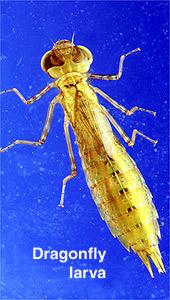The adult Dragonfly has a long and narrow body. It holds its wings out to its sides when perched. Dragonflies also have very large eyes that touch each other in the center. Different species may be different colors: red, green, blue or brown.
The adult Damselfly is similar, but holds its wings together over its back (like a butterfly) when perched. Its eyes do not meet in the middle of its head. Damselflies are also much smaller than Dragonflies. The Damselflies at Mather Field are usually blue or blue-green.
Both Dragonfly and Damselfly larvae are aquatic. The larvae have large eyes similar to the adults. The Damselfly larva has a long and narrow body with three feather-like tails which are its gills. The Dragonfly larva has a fatter body and no external gills.
Scientific name: Many different species
Phylum: Arthropoda
Subphylum: Insecta
Class: Odonata
Order: Anisoptera (Dragonflies), Zygoptera (Damselflies)
Habitat: All freshwater wetlands, including lakes, ponds, marshes, streams, rivers and vernal pools
Size: 2.2 to 8.0 cm long (adults)
Fun Facts:
Dragonflies are one of the most ancient of the flying insects. There are fossil records of Dragonflies from before the dinosaurs. Some of the fossil Dragonflies have wingspans of 32 cm (wider than a frisbee!). Dragonflies are now smaller, but have otherwise changed very little since prehistoric times.
Life Cycle:
The female Dragonflies and Damselflies lay their eggs in the water. The Dragonfly lays its eggs directly in the water, while the Damselfly inserts its eggs in underwater vegetation. The eggs hatch within a few days and the larvae grow quickly.
Each larva molts 8 to 16 times during its growth. When a larva molts, it sheds its old, too-tight skin. Underneath is a new, larger skin into which it can grow. From the last molt, an adult emerges. Unlike butterflies, there is no pupal stage between larva and adult. The newly emerged adult is fragile and very shiny. It takes a day or two for its skin and wings to harden.
Ecology:
The larvae of the Dragonfly and Damselfly are predators. They eat many of the critters that occupy vernal pools including Mosquito larva, tadpoles, Fairy Shrimp, Tadpole Shrimp, and many others. They have special mouthparts, which allow them to grab any prey that swims into view. The larvae are eaten by wading birds and fish.
Adult Dragonflies and Damselflies are also predators. They eat flying insects of all types. One of the common names for the Dragonfly is Mosquito Hawk, referring to its hunting of Mosquitoes. The adults are eaten by birds and spiders.
Conservation:
The larvae of Dragonflies and Damselflies are one of the signs of a healthy aquatic ecosystem. They show that the food web is intact and functioning. The presence of adults near water is also a good indication of a healthy ecosystem. When the adults or larvae are absent, it usually means that the habitat is polluted.
Investigate:
Some species of Dragonflies sit on a perch waiting for a meal to fly close. They then fly off the perch to catch the insect and immediately return to the same perch. This behavior is similar to that shown by birds known as flycatchers. Watch for Dragonflies with this behavior at Mather Field.

